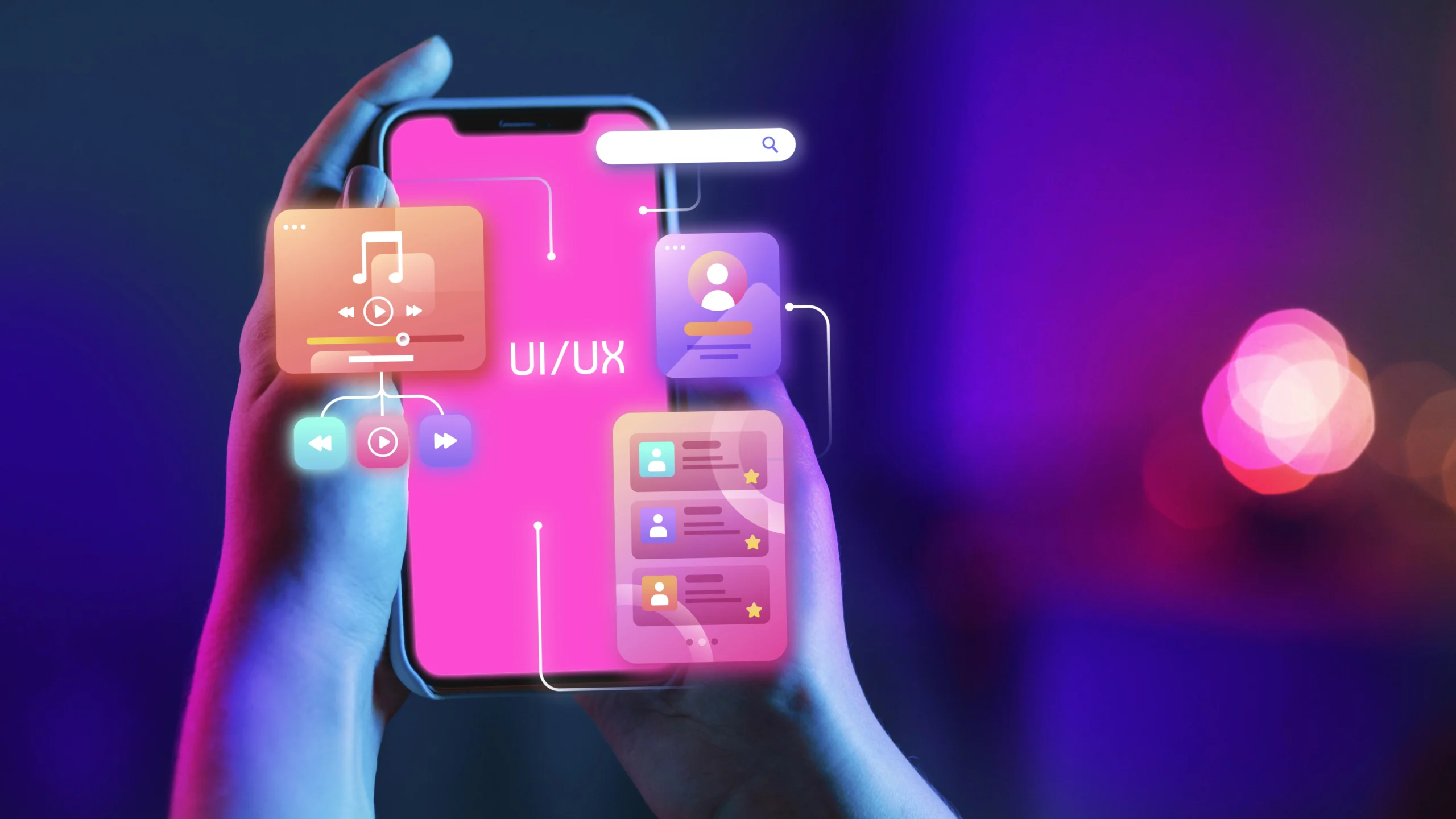Why Mobile App Design is Important for User Experience?
Author: Laila Meraj
24 October, 2024
Mobile applications have become an integral part of our daily lives, in the ever-evolving landscape of digital technology. From managing finances to ordering food, scheduling appointments to staying connected with loved ones, mobile apps serve a myriad of purposes.
However, not all apps are created equal. The difference between a successful app and one that fails to gain traction often lies in its design. In this comprehensive exploration, we’ll delve into why mobile app design is crucial for user experience (UX) and how it impacts the overall success of an application.

The Fundamentals of Mobile App Design
Before we dive into the importance of mobile app design for UX, let’s establish a foundation by understanding what constitutes good mobile app design.
Visual Design
Visual design encompasses the aesthetic elements of an app, including:
- Color scheme
- Typography
- Iconography
- Layout
- Imagery
A well-executed visual design not only makes an app visually appealing but also contributes to its usability and user engagement.
Interaction Design
Interaction design focuses on how users interact with the app. It includes:
- Navigation patterns
- Gesture controls
- Feedback mechanisms
- Transitions and animations
Effective interaction design ensures that users can intuitively navigate the app and accomplish their goals with minimal friction.
Information Architecture
Information architecture (IA) is the structural design of information spaces. In mobile app design, it involves:
- Organizing content
- Structuring navigation
- Labeling elements
- Designing search systems
A well-planned IA helps users find information and complete tasks efficiently.
The Impact of Mobile App Design on User Experience
Now that we’ve covered the basics, let’s explore why mobile app design is critical for user experience.
First Impressions Matter
In the competitive world of mobile apps, users form opinions about an app within the first few seconds of interaction. A study by Google found that it takes only 50 milliseconds for users to form an aesthetic opinion about a website, and the same principle applies to mobile apps.
A well-designed app with an appealing interface can create a positive first impression, encouraging users to explore further. On the other hand, a poorly designed app may lead to immediate abandonment.
Consider the following code snippet that demonstrates how to create a visually appealing splash screen in Android using Kotlin:
class SplashActivity : AppCompatActivity() {
override fun onCreate(savedInstanceState: Bundle?) {
super.onCreate(savedInstanceState)
setContentView(R.layout.activity_splash)
// Use a handler to delay loading the main activity
Handler().postDelayed({
startActivity(Intent(this, MainActivity::class.java))
finish()
}, 2000) // 2000 milliseconds delay
}
} This code creates a splash screen that displays for 2 seconds before transitioning to the main activity, giving users a visually pleasing introduction to the app.
Cognitive Load Reduction
Cognitive load refers to the mental effort required to use an app. Good mobile app design aims to reduce cognitive load, making the app easier and more pleasant to use.
Techniques for reducing cognitive load include:
- Progressive disclosure: Revealing information gradually as needed
- Chunking: Grouping related information together
- Consistency: Using familiar patterns and elements across the app
Here’s an example of how progressive disclosure can be implemented in React Native:
import React, { useState } from 'react';
import { View, Text, TouchableOpacity } from 'react-native';
const ProgressiveDisclosure = () => {
const [expanded, setExpanded] = useState(false);
return (
<View>
<Text>Basic Information</Text>
<TouchableOpacity onPress={() => setExpanded(!expanded)}>
<Text>{expanded ? 'Show Less' : 'Show More'}</Text>
</TouchableOpacity>
{expanded && (
<View>
<Text>Additional details here...</Text>
</View>
)}
</View>
);
};This component initially shows basic information and allows users to expand for more details, reducing the initial cognitive load.
Emotional Design
Emotional design in mobile apps goes beyond mere functionality. It aims to create a connection between the user and the app, evoking positive emotions and enhancing the overall user experience.
Elements of emotional design include:
- Micro-interactions: Small, engaging animations
- Personalization: Tailoring the experience to individual users
- Storytelling: Guiding users through the app with a narrative
Here’s a Swift example of a simple micro-interaction using a button press:
import UIKit
class MicroInteractionButton: UIButton {
override func touchesBegan(_ touches: Set<UITouch>, with event: UIEvent?) {
super.touchesBegan(touches, with: event)
UIView.animate(withDuration: 0.1, animations: {
self.transform = CGAffineTransform(scaleX: 0.95, y: 0.95)
})
}
override func touchesEnded(_ touches: Set<UITouch>, with event: UIEvent?) {
super.touchesEnded(touches, with: event)
UIView.animate(withDuration: 0.1, animations: {
self.transform = CGAffineTransform.identity
})
}
} This code creates a button that slightly shrinks when pressed and returns to its original size when released, providing visual feedback to the user.
Accessibility and Inclusivity
A well-designed mobile app should be accessible to all users, including those with disabilities. Incorporating accessibility features not only broadens your user base but also improves the overall user experience for everyone.
Key accessibility considerations include:
- Color contrast
- Text size and readability
- Voice over support
- Alternative text for images
Here’s an example of how to add accessibility labels to UI elements in React Native:
import React from 'react';
import { View, Text, TouchableOpacity } from 'react-native';
const AccessibleButton = ({ onPress, label }) => (
<TouchableOpacity
onPress={onPress}
accessible={true}
accessibilityLabel={label}
accessibilityRole="button"
>
<Text>{label}</Text>
</TouchableOpacity>
);
const App = () => (
<View>
<AccessibleButton onPress={() => {}} label="Submit Form" />
</View>
); This code creates a button component that includes accessibility properties, making it easier for screen readers to interpret and convey information to users with visual impairments.
Performance Optimization
While not strictly a design element, the performance of a mobile app significantly impacts user experience. A well-designed app should not only look good but also perform smoothly.
Performance considerations in mobile app design include:
- Optimized images and assets
- Efficient use of system resources
- Smooth animations and transitions
- Fast load times
Here’s a Kotlin example of how to implement efficient image loading using Glide, a popular image loading library for Android:
import com.bumptech.glide.Glide
import com.bumptech.glide.load.engine.DiskCacheStrategy
class ImageLoader(private val context: Context) {
fun loadImage(imageUrl: String, imageView: ImageView) {
Glide.with(context)
.load(imageUrl)
.diskCacheStrategy(DiskCacheStrategy.ALL)
.placeholder(R.drawable.placeholder_image)
.error(R.drawable.error_image)
.into(imageView)
}
} This code efficiently loads and caches images, improving performance and reducing data usage.
Gesture-Driven Interfaces
Mobile devices offer unique interaction opportunities through touch gestures. A well-designed mobile app leverages these gestures to create intuitive and efficient user interfaces.
Common gestures include:
- Tap
- Swipe
- Pinch to zoom
- Long press
- Double tap
Here’s a Swift example of implementing a swipe gesture in iOS:
import UIKit
class SwipeGestureViewController: UIViewController {
override func viewDidLoad() {
super.viewDidLoad()
let swipeGesture = UISwipeGestureRecognizer(target: self, action: #selector(handleSwipe(_:)))
swipeGesture.direction = .right
view.addGestureRecognizer(swipeGesture)
}
@objc func handleSwipe(_ gesture: UISwipeGestureRecognizer) {
if gesture.direction == .right {
print("Swiped right")
// Perform action here
}
}
} This code adds a right swipe gesture recognizer to the view controller, allowing for custom actions to be performed when the user swipes right.
Consistency Across Platforms
While maintaining platform-specific design guidelines is important, consistency in branding and core functionality across different platforms (iOS, Android, web) is crucial for a cohesive user experience.
Cross-platform consistency considerations include:
- Brand colors and typography
- Core feature set
- Navigation patterns
- Iconography
Frameworks like React Native or Flutter can help maintain consistency across platforms while still allowing for platform-specific optimizations.
Data Visualization
For apps that deal with complex data, effective data visualization is crucial. Well-designed charts, graphs, and infographics can make information more digestible and engaging for users.
Here’s a React Native example using the react-native-charts-wrapper library to create a simple line chart:
import React from 'react';
import { LineChart } from 'react-native-charts-wrapper';
const DataVisualization = () => (
<LineChart
data={{
dataSets: [{
values: [{y: 1}, {y: 2}, {y: 1}, {y: 3}, {y: 4}],
label: 'Dataset 1',
}]
}}
xAxis={{
valueFormatter: ['Jan', 'Feb', 'Mar', 'Apr', 'May']
}}
animation={{
durationX: 300,
durationY: 300,
}}
legend={{
enabled: true,
textSize: 14,
form: 'SQUARE',
formSize: 14,
xEntrySpace: 10,
yEntrySpace: 5,
formToTextSpace: 5,
wordWrapEnabled: true,
maxSizePercent: 0.5,
}}
/>
); This code creates a line chart with custom styling and animations, making data more visually appealing and easier to understand.
Conclusion
The importance of mobile application design in shaping user experience cannot be overstated. From creating positive first impressions to reducing cognitive load, from evoking emotions to ensuring accessibility, every aspect of mobile app design plays a crucial role in determining how users interact with and perceive an app.
As we’ve explored through various technical examples, implementing good design principles often requires a deep understanding of both design concepts and programming techniques. The fusion of aesthetics and functionality, underpinned by solid technical implementation, is what truly elevates a mobile app’s user experience.
Remember, great mobile app design is an ongoing process. It requires continuous iteration, user feedback, and adaptation to evolving technologies and user expectations. By staying committed to excellence in mobile app design, we can create digital experiences that truly enrich and simplify people’s lives.
Ready to build an appealing app design? Xorbix Technologies has a team of expert developers specializing in creating custom, high-performance applications for businesses of all sizes.
Read more related to this blog:
- How Mobile Apps Are Transforming Manufacturing
- Data Security in Manufacturing Mobile Apps
- The Future of Smart Manufacturing: Integrating IoT with Mobile Apps




